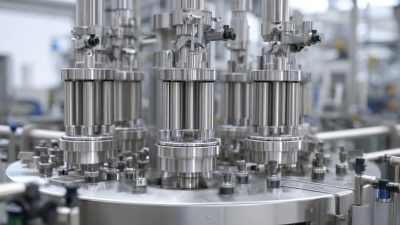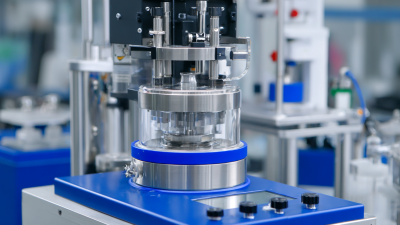 You know, in today's world of food production, having
consistent and stable emulsions is more important than ever. That’s where a good homogenizer for emulsions really comes in handy.
It helps ensure that everything mixes together perfectly and stays that way over time, giving your food the right texture and quality. A leading player in this tech space is
CAS PETER (HANGZHOU) NANOTECHNOLOGY CO., LTD. — they’re all about developing and selling high-pressure homogenizers and
microfluidizers. Their focus on cutting-edge nanotechnology solutions means they’re really meeting the different needs across various industries. This, in turn, helps food producers make
better, more reliable products, which everyone ends up loving. Once manufacturers get the hang of how homogenization works, they can use these advanced tools to keep their products
consistent and make customers happy — simple as that.
You know, in today's world of food production, having
consistent and stable emulsions is more important than ever. That’s where a good homogenizer for emulsions really comes in handy.
It helps ensure that everything mixes together perfectly and stays that way over time, giving your food the right texture and quality. A leading player in this tech space is
CAS PETER (HANGZHOU) NANOTECHNOLOGY CO., LTD. — they’re all about developing and selling high-pressure homogenizers and
microfluidizers. Their focus on cutting-edge nanotechnology solutions means they’re really meeting the different needs across various industries. This, in turn, helps food producers make
better, more reliable products, which everyone ends up loving. Once manufacturers get the hang of how homogenization works, they can use these advanced tools to keep their products
consistent and make customers happy — simple as that.
You know, emulsification is such a key step in making food products the way they are today. It’s what keeps oil and water-based ingredients happily mixed without separating. Food homogenizers are pretty much the heroes here—they use high shear forces to break down fat globules into tiny bits, less than a micron in size, making everything blend perfectly. Interestingly, a report by Grand View Research estimates that the global market for these homogenizers could hit around $5.4 billion by 2027. That really shows how important this tech has become in modern food creation.

Now, the science behind these machines is pretty cool. They boost the stability and texture of emulsions by creating smaller, more uniform droplets during processing. This not only helps in getting better flavor release but also improves the mouthfeel—think mayo or salad dressings. There was a study in the Journal of Food Science that found using more advanced homogenization techniques can boost emulsion stability by up to 50%. That means longer shelf lives and fewer additives needed, which is a win-win. So yeah, understanding how emulsification works and the role of homogenizers is pretty much essential for food makers trying to deliver top-quality, innovative products that consumers love.
Homogenizers are pretty much the backbone of modern food production when it comes to making sure everything’s mixed evenly and stays stable. There are actually a few different types out there, each suited for specific jobs. For example, high pressure homogenizers are really popular—they’re great at breaking down particles and keeping emulsions stable. In fact, a recent market report from Grand View Research predicts that the global market for these high pressure machines could hit around 2.4 billion US dollars by 2027. That growth is largely fueled by everyone wanting more innovative and exciting food products.
Another key player is the microfluidizer. It works by pushing materials through tiny channels at super high pressures. Not only does it make the process more efficient, but it also boosts the flavor and texture of the food. There’s even research in the Journal of Food Engineering showing that microfluidization can cut down particle sizes by about half, leading to much smoother textures. As a company focused on advanced nanotech solutions, CAS PETER (HANGZHOU) NANOTECHNOLOGY CO., LTD specializes in both high pressure homogenizers and microfluidizers, serving the food industry along with other fields.
All in all, these tools are pretty amazing and essential for creating high-quality food products today.
| Homogenizer Type | Application | Pressure Range (bar) | Typical Output (L/h) | Advantages |
|---|---|---|---|---|
| High-Pressure Homogenizer | Dairy Products, Sauces | 50 - 400 | 500 - 5000 | Efficient emulsification, Consistent product quality |
| Ultrasonic Homogenizer | Beverages, Dressings | 1 - 10 | 10 - 1000 | Compact design, Low energy consumption |
| Batch Homogenizer | Soups, Smoothies | 20 - 100 | 100 - 2000 | Versatile, Suitable for small batches |
| Continuous Homogenizer | Liquid Foods, Dressings | 20 - 200 | 2000 - 10000 | High throughput, Ideal for large-scale production |
| Microfluidizer | Nut butters, Sauces | 100 - 300 | 10 - 400 | Uniform particle size, Enhanced flavor release |
You know, when it comes to modern food stuff, emulsion stability is kind of a big deal. It all depends on a few key things—like which emulsifiers you pick, the size of those droplets, and even the environmental stuff like temperature and pH. Recently, folks have been really digging into nanoemulsions because those tiny droplets pack a punch—they’re way more stable and tend to hold up better. For instance, using chitosan nanoparticles to stabilize Pickering emulsions shows a lot of promise, especially when it comes to keeping fresh produce fresh after harvest. It’s a clever way to tackle the big problem of postharvest losses.

On top of that, researchers are trying out newer emulsifiers like fish protein and soy protein isolate. These protein-based ingredients do a really good job of making emulsions more stable and functional. They don’t just help keep everything mixed well, but they also boost how well bioactive compounds—like nutrients or flavors—are delivered in food. Plus, there's a growing trend of using cellulose-based emulsions, which are exciting because they add an extra punch of sustainability and quality. Overall, these innovations are helping food companies improve the stability and overall quality of their emulsified products—pretty cool, right?
Homogenizers are pretty much the unsung heroes in modern food making. They help create that smooth, consistent texture we expect in sauces, dressings, and dairy. But to get the most out of your machine, you gotta stick to a few best practices. For example, keeping an eye on the pressure settings is key – if you get that right, it means the particles are broken down uniformly, making the final product just feel better in your mouth.
Quick tip: Always calibrate your homogenizer before firing it up and check for any signs of wear every now and then. It may seem small, but it helps the machine last longer and makes sure your emulsions stay stable. Also, don’t forget about ingredient temperature—using cold ingredients can actually make things easier because it lowers viscosity, making it simpler for the homogenizer to do its job.
Another thing to keep in mind is timing. You need to know exactly when to add the emulsifier—this can really make or break the stability of your final product. It’s a good idea to run some small tests before going full throttle, so you can figure out the perfect conditions for your specific recipe.
And here’s a pro tip: jot down every step—like ingredient temperatures, processing times, pressure levels. Keeping records helps you stay consistent, and troubleshooting becomes way easier if something doesn’t go as planned. If you pay attention to these tips, not only will your emulsions improve, but the overall quality of your food products will be way up there.
Homogenization is pretty crucial when it comes to getting stable emulsions in food production, but, honestly, it’s not without its hiccups. One of the most common issues? Separation. That’s when the oil and water just can't seem to stay mixed and kinda separate back into their own layers. Usually, this happens if you’re not pushing enough energy into the process or maybe not using enough emulsifier. To fix this, you’ll want to tweak your homogenizer settings—playing around with the pressure and flow rate so it can really do its job of breaking things down and dispersing everything evenly. That'll help make the emulsion more stable and less likely to separate later on.
Another thing folks often run into is ending up with big droplet sizes. And honestly, that can mess with how the product feels in your mouth and impacts overall quality. Usually, this happens if the homogenizer isn’t set up quite right or if you’re using the wrong emulsifying agents. The trick here is to experiment a bit—try different emulsifiers that match the kind of texture and stability you're after, and consider running the mixture through the homogenizer a few more times. That’ll help break down the bigger droplets into smaller ones, giving you that smooth, nice texture you want, plus better stability overall. Just keeping an eye on these key details and tweaking as needed can make a big difference in troubleshooting and getting the best results from your emulsification process.
: Emulsification is a vital process that ensures stable mixtures of oil and water-based ingredients, which is essential for products like sauces and dressings.
Food homogenizers apply high shear forces to break down fat globules to less than 1 micron in diameter, achieving uniform distribution and enhancing emulsion stability.
The intense shear and turbulence from homogenization facilitate the formation of smaller, more uniform droplets, leading to improved flavor release and mouthfeel in products.
The global food homogenizer market is projected to reach approximately $5.4 billion by 2027.
Best practices include monitoring pressure settings, calibrating the machine before use, checking for wear on components, and considering the temperature of ingredients.
Documenting each stage, from ingredient temperatures to homogenization times, helps ensure consistency in production and aids in troubleshooting any issues that may arise.
Using cold emulsions can reduce viscosity, making it easier for the homogenizer to achieve desired results for emulsification.
It is essential to understand the optimal point for introducing emulsifiers, as this can significantly impact the stability of the final emulsion.
Advanced homogenization techniques can increase emulsion stability by up to 50%, extending shelf life and reducing the need for additives.
Potential issues include instability of emulsions or inconsistent product quality, which can be mitigated by following best practices and documenting processes.
Hey there! So, I read this article called "Understanding the Role of Homogenizers in Modern Food Production," and honestly, it’s pretty fascinating. It dives into how crucial homogenizers are when it comes to creating those smooth, stable food products we all enjoy. The article breaks down the science behind emulsification — you know, how fats and liquids get combined perfectly — and talks about the different types of homogenizers out there, like high-pressure ones and microfluidizers. What's really handy is how it highlights the key factors that affect how stable an emulsion is, along with some practical tips for using these machines properly in food processing. Oh, and it throws in some common problems you might run into and offers small troubleshooting tricks to handle them. Absolutely helpful if you're into food tech or just curious about how those perfect dips, sauces, and dressings get made!
At CAS PETER (HANGZHOU) NANOTECHNOLOGY CO., LTD, we’re really passionate about pushing the boundaries of food technology. Our high-pressure homogenizers are all about making those emulsions super stable and ensuring top-notch quality. We’re committed to both researching and selling these state-of-the-art solutions, helping industries up their game in producing consistent, high-quality products. It’s all about making food better, one homogenizer at a time!







